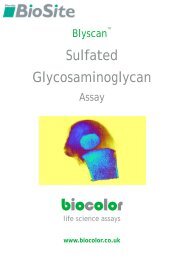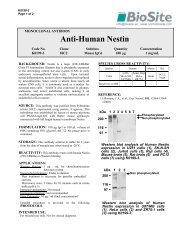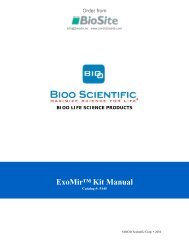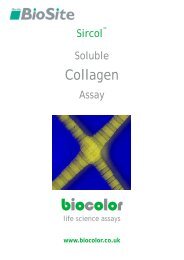Fastin ELASTIN Assay Manual - Nordic Biosite
Fastin ELASTIN Assay Manual - Nordic Biosite
Fastin ELASTIN Assay Manual - Nordic Biosite
Create successful ePaper yourself
Turn your PDF publications into a flip-book with our unique Google optimized e-Paper software.
MEASUREMENT OF INSOLUBLE <strong>ELASTIN</strong><br />
The <strong>Fastin</strong> <strong>Assay</strong> can be used to measure insoluble cross‐linked elastin. Insoluble elastin is<br />
extracted from tissue in the form of soluble cross‐linked polypeptide elastin fragments.<br />
Insoluble elastin can be converted into either soluble α‐elastin or κ‐elastin. After extraction<br />
the samples can be assayed by the procedure described for soluble elastin.<br />
Conversion of insoluble elastin to water soluble α‐elastin<br />
[a] Tissue samples are weighed (decide if the elastin content is to be expressed as wet<br />
weight or dry weight, (μg/mg), of tissue).<br />
Cut tissue into small fragments for extraction.<br />
Place the weighed samples into centrifuge tubes (~10 x 2 cm) and add ~20 volumes<br />
of 0.25 M oxalic acid (assuming tissue density is 1.00 gm/cm3).<br />
[b] The tubes are then placed into a boiling water‐bath (or a metal heating block with the<br />
thermostat set at 100ºC), for 60 minutes. Do not tighten tube caps.<br />
[c] Remove the tubes from the heat and cool to room temperature.<br />
Centrifuge at ~3000 rpm for 10 minutes.<br />
Pipette off the liquid and retain this extract in labeled containers.<br />
[d] To the residual tissue in the tubes add a further 20 volumes of 0.25 M oxalic acid and<br />
again heat for 60 min. Up to three heat extractions should be initially used to check<br />
that complete solubilisation of the tissue elastin has occurred<br />
[e] Some tissue material, such as that from foetal or immature animals, can be solubilised<br />
after one or two extractions. Tissue from mature or old animals, including aged human<br />
tissues, may require up to three extractions.<br />
[f] Initially when using new test material retain each of the oxalic acid extracts separately<br />
and analyze each for elastin; to establish that elastin extraction was quantitative.<br />
The last extract should contain no elastin.<br />
Elastin extracted from mature tissue, (elderly adult human tissue), will often produce<br />
yellow coloured extracts.<br />
[g] The tissue elastin in the form of α‐elastin which has an average molecular weight of<br />
60‐84 KDa. The extract can now be directly assayed using the procedure described<br />
for soluble elastins.<br />
Retain a record of the extract volumes to permit calculation of the tissue elastin content.<br />
12











